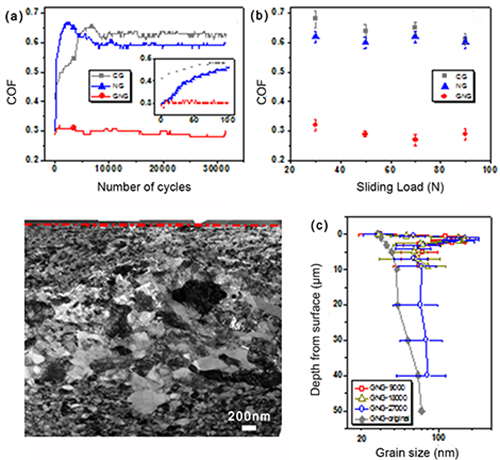金属材料的干摩擦系数(通常处于0.6-1.2之间)普遍较高,其原因是摩擦过程中接触表面下方产生塑性变形,导致表面粗糙化以及形成易脱落的摩擦层。在工程应用中,降低金属零件之间的摩擦系数对提高其可靠性及效率尤为重要,但在技术上极具挑战性。纳米金属有限的塑性变形能力使其在摩擦过程中容易发生应变局域化,成为制约降低金属摩擦系数的瓶颈。
我们利用表面机械碾磨技术成功地在Cu-Ag合金表面制备出梯度纳米结构,在高载荷摩擦过程中,其干摩擦系数显著降低(Fig. 1(a)&(b))。以载荷为50 N为例,摩擦系数由粗晶态0.64降至0.29。同时其磨损速率呈量级降低。梯度纳米结构为降低传统金属材料的摩擦磨损开辟了全新的途径。
在单次及重复滑动条件下,样品表面始终光滑如初,有效抑制了摩擦导致的表面粗糙化。亚表层微观结构显示,最表层纳米晶尺寸稳定不变,其下方发生晶粒长大现象(Fig. 1(c)),其塑性变形主导机制为机械驱动的晶界迁移。可见在高载荷30000周次滑动过程中,梯度结构Cu-Ag合金表现出高稳定性,有效抑制了表面粗糙化以及脆性摩擦层的形成,这正是其展示出低摩擦现象的根本原因。梯度纳米结构对于提高工程材料能源效率与产品寿命具有重要启示。该研究成果发表于2016年12月9日出版的《Science Advances》(《科学-进展》)。

Fig. 1: (a) Variation of COFs with slidingcycles for the CG, NG, and GNG Cu-Ag samples sliding against WC-Co balls under a load of 50 N, a slide stroke of 1 mm, and a velocity of 10 mm/s. Inset shows COFs during the initial 100 cycles. (b) Variations of the steady-state COFs with the applied load for the three samples.(c) Typical cross-sectional TEM image of the subsurface layer in the GNG sample after sliding for 27,000 cycles and variation of the mean grain sizes along the depth determined from TEM images in the GNG samples before and after sliding for 9000, 18,000, and 27,000 cycles, respectively.